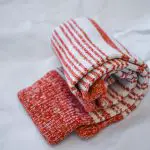When it comes to layering in cold climates, silk can be both a tempting choice and a bit of a gamble. Its lightweight and breathable nature makes it comfortable as a base layer, but you might wonder how well it holds up against harsher temperatures. There are some clear advantages, yet the potential drawbacks could leave you reconsidering. So, is silk truly the right fabric for your winter wardrobe? Let’s explore the details.
Table of Contents
Key Takeaways
- Silk is lightweight and thin, making it comfortable for layering under bulkier garments in cold climates.
- Its natural breathability helps regulate body temperature, providing comfort without excessive heat retention.
- While silk offers a luxurious feel, it provides limited insulation in extreme cold conditions.
- Blending silk with other fibers enhances thermal insulation and durability, making it more suitable for cold weather.
- Silk is biodegradable and has lower water usage than cotton, contributing to sustainability, though ethical concerns exist in its production.
Understanding Silk’s Breathability and Moisture-Wicking Properties
When you think about layering for cold climates, silk’s breathability and moisture-wicking properties can make a significant difference. This natural fiber allows air to circulate, helping to regulate your body temperature.
When you wear silk, it keeps you warm without trapping excess heat, preventing that clammy feeling often associated with heavier fabrics. Furthermore, silk effectively draws moisture away from your skin, which is essential during physical activities or sudden temperature changes.
Silk keeps you warm without excess heat and draws moisture away, ensuring comfort during physical activities and temperature changes.
As sweat evaporates, you stay dry and comfortable, making it easier to enjoy your time outdoors. Plus, silk’s smooth texture feels luxurious against your skin, enhancing your layering experience.
With silk, you’re not just staying warm; you’re also ensuring comfort throughout your day in cold climates.
Advantages of Using Silk for Layering
While many fabrics can provide warmth, silk stands out for its unique advantages when it comes to layering. You’ll appreciate how lightweight and thin silk is, allowing you to wear it comfortably under bulkier garments without feeling restricted.
Its natural breathability helps regulate your body temperature, keeping you warm without overheating. Additionally, silk’s moisture-wicking properties mean it draws sweat away from your skin, keeping you dry and comfortable during chilly activities.
The luxurious feel of silk against your skin can enhance your overall wearing experience, making it a delightful choice for layering. Plus, its versatility allows you to easily dress it up or down, ensuring you stay stylish while staying warm in cold climates.
Potential Drawbacks of Silk in Cold Weather
Although silk offers numerous benefits for layering in cold climates, it also has some drawbacks that you should consider. One major issue is its limited insulation properties, which can leave you feeling cold in extreme temperatures. Additionally, silk can be delicate and prone to snags, especially in rugged environments.
| Drawback | Impact | Consideration |
|---|---|---|
| Limited insulation | May not retain heat effectively | Layer with warmer fabrics |
| Delicate nature | Susceptible to damage | Handle with care |
| Cost | Can be more expensive than others | Budget accordingly |
These factors can affect your overall comfort and functionality in cold weather, so it is crucial to weigh them carefully before choosing silk for your layers.
The Benefits of Silk Blends for Enhanced Insulation
Silk blends can markedly enhance insulation without sacrificing the luxurious feel of silk. By incorporating other fibers, these blends provide a perfect balance of warmth and comfort, making them ideal for cold climates.
You’ll appreciate the added benefits of these combinations, as they often deliver better heat retention and moisture-wicking properties.
- Improved warmth: Blending silk with materials like wool or polyester boosts thermal insulation.
- Moisture management: These blends help wick away sweat, keeping you dry and comfortable.
- Durability: Adding fibers often increases the lifespan of your garments, making them more resilient to wear and tear.
Ideal Layering Combinations With Silk
When you’re planning your winter wardrobe, incorporating silk into your layering strategy can elevate both warmth and style.
Start with a silk camisole or turtleneck as your base layer. This lightweight piece not only feels luxurious against your skin but also provides a smooth foundation for other layers.
Begin your layering with a silk camisole or turtleneck for a luxurious and smooth base.
Next, add a cozy wool or cashmere sweater for insulation. On top, a chic silk scarf can add an extra layer of warmth while enhancing your overall look.
For outerwear, consider a down jacket that allows for easy movement and retains heat.
Complete your outfit with a pair of silk-lined gloves to keep your hands toasty. This combination offers the perfect balance of elegance and functionality for cold climates.
The Role of Temperature Regulation in Silk Fabrics
Incorporating silk into your winter wardrobe not only enhances style but also plays a significant role in temperature regulation. Silk’s natural properties allow it to breathe while providing warmth, making it an excellent choice for layering.
When you wear silk, you’ll experience moisture-wicking benefits that keep you dry and comfortable, even in fluctuating temperatures.
- Silk helps maintain your body heat, ensuring warmth without bulk.
- It regulates your temperature by allowing air circulation, preventing overheating.
- The lightweight nature of silk adds minimal weight, making it easy to layer without feeling restricted.
Sustainability and Environmental Impact of Silk
When considering silk, you’ll appreciate its natural fiber benefits, like biodegradability and comfort.
However, the production process raises some concerns, especially regarding the environmental impact and ethical practices.
It’s essential to weigh these factors as you choose silk for your cold-weather layering needs.
Natural Fiber Benefits
Although many fabrics contribute to environmental challenges, silk stands out as a sustainable option due to its natural origins and biodegradable properties.
When you choose silk, you’re not just opting for a luxurious fabric; you’re also supporting eco-friendly practices.
Here are some benefits of silk as a natural fiber:
- Biodegradability: Unlike synthetic fabrics, silk decomposes naturally, reducing landfill waste.
- Renewable resource: Produced from silkworms, silk can be harvested without harming the environment.
- Low water usage: Silk farming requires considerably less water than cotton, making it a more sustainable choice.
Production Process Concerns
While silk offers impressive natural benefits, its production process raises important sustainability and environmental concerns.
The cultivation of silkworms often involves significant pesticide use, which can harm local ecosystems. Additionally, the water-intensive farming practices required for mulberry trees, the primary food source for silkworms, can strain freshwater resources, especially in arid regions.
You’re also likely aware that traditional silk production requires boiling silkworms alive, raising ethical questions about animal welfare. Moreover, many silk factories have poor working conditions and low wages for laborers.
If you’re considering silk for your wardrobe, it’s essential to seek out ethically produced options or consider alternative fabrics that offer a lower environmental impact without sacrificing comfort or style.
Final Thoughts on Using Silk for Layering in Cold Climates
When considering silk for layering in cold climates, you’ll find it offers a unique balance of comfort and warmth.
While it excels in breathability, you might’ve to weigh the trade-off between feeling cozy and staying warm.
Additionally, silk’s lightweight nature makes it a great choice for active wear, allowing you to move freely without bulk.
Overall Effectiveness for Layering
Silk proves to be an effective choice for layering in cold climates, as it offers a unique combination of warmth and breathability.
When you choose silk for your base layers, you’ll appreciate how it retains heat without trapping moisture. This balance makes it ideal for maintaining comfort during outdoor activities.
- Lightweight: Silk layers won’t add bulk, allowing for easier movement.
- Versatile: You can easily pair silk with other fabrics, enhancing your overall layering system.
- Temperature Regulation: Silk helps regulate body temperature, keeping you warm in the cold and cool when it warms up.
Comfort vs. Warmth Trade-off
Choosing silk for layering presents a unique comfort versus warmth trade-off that can influence your outdoor experience. While silk feels luxurious against your skin and provides breathability, it may not offer the same level of insulation as thicker materials.
Here’s a quick overview to help you evaluate your options:
| Aspect | Silk |
|---|---|
| Comfort | High |
| Warmth | Moderate |
| Weight | Lightweight |
| Moisture Wicking | Good |
You might find silk ideal for maintaining comfort while layering, but if warmth is your top priority, you may want to take into account adding thicker fabrics over silk. Balancing both aspects will enhance your cold-weather layering strategy.
Suitability for Active Wear
While you might appreciate silk’s luxurious feel, its suitability for active wear in cold climates can be a mixed bag. When engaging in physical activity, you need fabrics that can handle sweat, maintain warmth, and allow for movement.
Silk’s moisture-wicking properties are decent, but it can become damp and chilly when you’re active. Here are some considerations:
- Breathability: Silk allows for good air circulation but may not dry quickly enough during intense workouts.
- Durability: It’s not as robust as synthetic materials, making it less ideal for rigorous activities.
- Comfort: While soft against the skin, silk may not provide the stretch needed for full range of motion.
Frequently Asked Questions
How Does Silk Compare to Wool for Insulation?
Silk offers less insulation compared to wool, but it’s lightweight and breathable. You’ll find silk comfortable against your skin, while wool traps heat effectively, making it the go-to for colder conditions. Choose based on your needs.
Can Silk Be Worn Directly Against the Skin?
Silk feels like a gentle breeze against your skin. You can definitely wear it directly; its smooth texture and breathability make it comfortable. Just keep in mind any sensitivities you might have to fabrics.
What Are the Best Ways to Care for Silk Garments?
To care for silk garments, wash them gently in cold water with mild detergent, avoid wringing, and air dry. Store them in a cool, dark place, and consider using padded hangers to maintain their shape.
Is Silk Layering Suitable for Extreme Cold Conditions?
Silk isn’t ideal for extreme cold conditions. While it’s lightweight and breathable, you’ll need thicker, warmer fabrics for insulation. Layering with silk might be fine, but it won’t provide enough warmth on its own.
Are There Alternatives to Silk for Layering?
When considering alternatives for layering, think about merino wool for warmth, synthetic fabrics for moisture-wicking, or fleece for insulation. Each offers unique benefits, so choose what best fits your needs and preferences for comfort.
- Best Fabrics for Fishing in Cold and Wet Weather - June 8, 2025
- Understanding MVTR (Moisture Vapor Transmission Rate) in Fabrics - June 8, 2025
- What Fabrics Are Best for Preventing Odor in Hot Weather? - June 8, 2025







